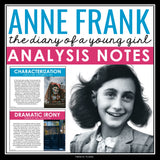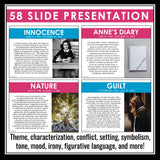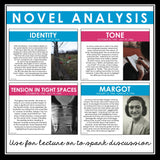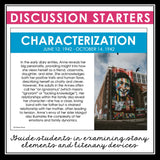Anne Frank The Diary of a Young Girl Analysis Notes - Analyzing Literary Devices
This resource will help you review the most important literary devices and important or recurring ideas in The Diary of a Young Girl by Anne Frank. This comprehensive 58-slide PowerPoint presentation explores key literary elements and how they develop in the text, organized by diary sections. The notes address genre, theme, recurring ideas, conflict, characterization, irony, mood, tone, symbolism, figurative language, and much more. The notes can be used for students to copy, or they can serve as discussion starters. After using this presentation, your students will have a much deeper understanding of Anne Frank’s diary.
This is included in a unit plan:
>>> Anne Frank: The Diary of a Young Girl Unit Plan
Included in the Anne Frank The Diary of a Young Girl Analysis Notes Resource:
➡️ Anne Frank Analysis Notes Presentation: This 58-slide PowerPoint presentation shares essential insights into how literary devices and story elements are used throughout The Diary of a Young Girl. After completing each diary section, share these notes with students for copying into their own notebooks or as prompts for class discussions.
Topics Covered in the Anne Frank Analysis Notes Resource:
Below are just some of the topics covered in this comprehensive presentation:
- Genre: Exploring the diary format and its impact as a personal narrative.
- Theme: Innocence, patience, guilt, identity, resilience, and more.
- Important Recurring Ideas: Adolescence, the need for space, self-preservation, forced maturity, and more.
- Conflict: Internal and external struggles faced by Anne and others in hiding.
- Characterization: Insights into Anne, her family, and the other residents of the Secret Annex.
- Tone: The evolution of Anne’s voice from innocence to experience.
- Mood: The shifting emotional atmosphere throughout the diary.
- Irony: Dramatic irony in reading Anne’s observations and predictions.
- Symbolism: Examining objects and events that represent deeper meanings.
- Figurative Language: Metaphors, similes, and vivid descriptions in Anne’s writing.
- Historical Context: Understanding the setting and its influence on the diary’s events.
- and much more!
The content in the historical context slides is organized by the following diary sections:
- Section 1: June 12, 1942 – October 14, 1942
- Section 2: October 20, 1942 – July 19, 1943
- Section 3: July 23, 1943 – January 12, 1944
- Section 4: January 15, 1944 – March 19, 1944
- Section 5: March 20, 1944 – May 3, 1944
- Section 6: May 5, 1944 – August 1, 1944
➡️ Want 10 free ELA resources sent to your inbox? Click here!







